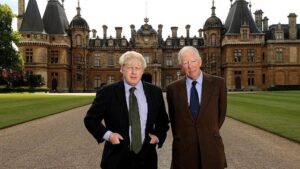The Secret Broker: Going (bored) ape in a new era of investing

Mario Klingemann’s Mitosis goes on view as part of ‘Natively Digital: A Curated NFT Sale’ at Sotheby's in London. (Pic: Getty)
After 35 years of stockbroking for some of the biggest houses and investors in Australia and the UK, the Secret Broker is regaling Stockhead readers with his colourful war stories — from the trading floor to the dealer’s desk.
I’m b-b-b-back!
As Stockhead pointed out this week, the AFR has been awash with headlines about crypto coins.
What triggered the biggest headline was the announcement in the UK that they are going to officially endorse and issue instruments on the blockchain.
The UK wants to become the central hub in the world on this issue and in doing so, become the go to place to be, for all things crypto.
So, the wild teenager has been invited back home to share a (bone china) cup of tea with Grandma, so he can explain to her how he has matured and see if she would add him back into her will.
It looks like he just may be able to pull this off.
A new era
The powers that be in the UK are going to allow the Royal Mail (Post Office) to issue more than stamps. They are going to allow them to produce Non-Fungible Tokens or NFT’s in teenager speak.
To understand what an NFT is, you need to peel back the onion and really look at what lies at the heart of crypto and NFT’s and how it all works.
In one of my first jobs in broking, it required me to fetch and return client files held in the firm’s library with one stern lady gatekeeper in charge of all of these files and what went into them.
If a partner wrote a letter, a carbon copy of that letter would be added to the client’s file, so there would only ever be two copies floating around. One original and one copy of its contents.
You could take a photocopy of said letter, but that would be a black and white copy only and never pass as an original.
Still today they use CC (carbon copy) and BCC (blind carbon copy) in email language. CC was the copy to the file and BCC may be a copy that was sent to, say, a trustee of one of their trusts.
When the file got too large with all the backwards and forwards correspondence, older dated paperwork was sent off to, of all places, Wales.
Apparently, in Wales, they had certain caves with the right humidity so that the paper would not perish over time but preserve it for 100’s of years if need be.
So, you have one original letter only and maybe one or two plain copies of that letter and that was it.
To forge a copy of that letter, would take an awful lot of planning and bribing of all the people involved in producing and delivering it, including getting to the Royal Post Office postman and switching envelopes.
Also, if money was to change hands, it was done by a paper cheque sent in the mail.
If it got lost it could be stopped and cancelled.
The blockchain
Fast forward to today, an email with an attached letter can be copied and sent around to thousands of different people, who can print off said letter, so there could be thousands of original copies floating around the planet.
And you have no control over who sees it and what they do with it.
However, now, when you involve the blockchain, it is like going back to the old days and only ever having one copy in circulation.
So, how does the blockchain work and why now is it starting to get official endorsements?
Each block in a blockchain is unique and over 1,000 computers around the world individually register each block (this is the mining bit they refer to) as they are generated and then add the blocks (of code) together to form the chain.
The set of computers cannot be compromised (you need to hack all of them at the same time) and the owners of them earn a small commission every time they all update the chain.
Basically, it allows for an electronic register to store and show one off individual transactions in the public arena.
And just like the 4 pin code you need at an ATM, each block needs a code to prove you own it.
Similarly, if you give your 4-pin numbers to someone, the same applies to the blockchain and therefore you both can be hacked.
NFT – Secret Broker edition
Going back to an NFT, I have found the perfect example of how it can be used and how it can become a win-win all round.
The aptly named Vinylkey allows a recording artist to release a limited edition of their music in vinyl and pressed into the vinyl is an NFC tag.
The tag can be tapped with a mobile phone (just like Applepay and Googlepay) and it will display all the features that make it a rare and collectable item.
The owner and anyone who also taps the record can see all the information that proves its providence plus the owner can log in (using their private pin number) and transfer ownership to another person.
If they do transfer ownership, the original recording artist also earns a royalty for allowing this to happen, and it can be set as a % of the transaction.
If you extend this to works of art, it will allow the original artist to earn some of the pricing upside each time it changes hands.
Now, the Royal Mail can produce limited edition stamps and proof of ownership and providence cannot be disputed.
For an explainer, this is how vinylkey works.
Granny will now be able to add modern works of art and limited edition stamp sets and even the odd Ape to her investment portfolio, and be advised by her Grandchildren on which ones they wish to inherit.
Having written all of this I am giggling at the prospect of some stuffy pinstriped solicitor reading out her will and then trying to scan and transfer ownership, according to Granny’s wishes — and needing the wayward teenage grand-son’s help.
And that’s after writing him out (and then back in).
I suspect he may go (Bored) Ape.
The Secret Broker can be found on Twitter here @SecretBrokerAU or on email at [email protected].
Feel free to contact him with your best stock tips and ideas.
UNLOCK INSIGHTS
Discover the untold stories of emerging ASX stocks.
Daily news and expert analysis, it's free to subscribe.
By proceeding, you confirm you understand that we handle personal information in accordance with our Privacy Policy.








